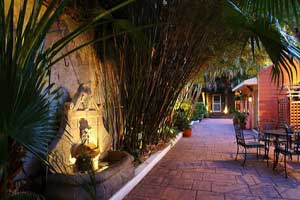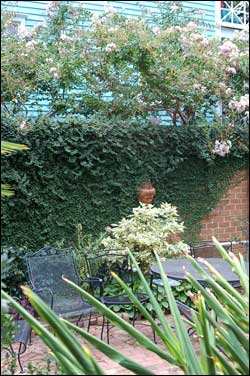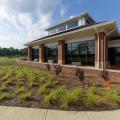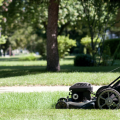Creative Courtyard Spaces
”Somewhere in every garden, there must be at least one spot, a quiet garden seat, in which a person—or two people—can reach into themselves and be in touch with nothing else but nature.”
--Christopher Alexandre, A Pattern Language
 A courtyard is a yard wholly or partly surrounded by walls or buildings. Differing than patios that open out to the greater landscape, courtyards tend to be separated spaces from the rest of the landscape. Courtyard spaces have been used in many countries for centuries, and these serve as rich models for creating our outdoor spaces.
A courtyard is a yard wholly or partly surrounded by walls or buildings. Differing than patios that open out to the greater landscape, courtyards tend to be separated spaces from the rest of the landscape. Courtyard spaces have been used in many countries for centuries, and these serve as rich models for creating our outdoor spaces.
In arid regions, the Islamic garden represents an image of paradise, and so it is called the paradise garden. The basic plan is a rectangular enclosure walled against the dust of the desert and divided into four sections by water channels.
China's courtyard homes create a quiet, intimate space. Walls shelter the home from the noise and dust of the street, while the inner courtyard remains open for light, fresh air and rainwater. Courtyards are ideal places for gardens, and Chinese gardeners often plant fragrant trees and shrubs that perfume the air around their homes.
 The courtyard gardens in Japan were meant to bring peace and meditation. They follow three traditional basic tea-garden features: a stone lantern, stepping stones, and a stone water basin. These features are viewed as ornamental rather than functional.
The courtyard gardens in Japan were meant to bring peace and meditation. They follow three traditional basic tea-garden features: a stone lantern, stepping stones, and a stone water basin. These features are viewed as ornamental rather than functional.
These historical landscapes from other countries have not only influenced American courtyard spaces, but also our patios and other outdoor living.
Just as a room in a house has walls, ceilings, and floors, so does a landscape space. As each room has a specific function it is designed for — kitchen for preparing food, living room for leisure, bedroom for sleeping — so do outdoor use areas. Courtyards should be designed to accommodate for their functions: outdoor eating space, relaxation and conversation, play area, or gardening. Just as a room functions a house, an outdoor courtyard space has three main structural components components: ceilings, walls and floors.
Ceilings may be composed of constructed materials such as building overhangs, arbors, fabrics, or other materials. Overhead elements may even include the open sky or the branches of large canopy trees overhanging the space.
There is a variety of floor materials that may be used in an outdoor space, and as courtyards tend to be smaller, detailed flooring materials such as pebbles or brick may provide a rich ground texture. There are many good paving materials that provide a wealth of colors and patterns. A solid pavement allows for permanent heavy use and provides direction for traffic. Turf and vegetated groundcovers are suitable for areas that are little walked on, and may provide a strong contrast against nearby hardscape materials.
For walls; fences or building sides may provide a sense of enclosure, and may be constructed of stone, brick, concrete, wood or metal. To provide a sense of separation from adjacent views, these walls work best when over six feet in height. Wood slat fences or open masonry block may provide a sense of enclosure yet still allow breezes into the courtyard area. Evergreen plants such as dense shrubs allow for privacy while still allowing breezes to pass through.
Just as a room in a house has doors and corridors to separate functions from other rooms, courtyards and other landscape spaces also have entry areas. These should be designed to make one feel that they are transitioning to or entering a special place. Gates are a wonderful element to add around any different outdoor space. An entry may be framed into a courtyard space by using a pergola or trellis and can create an inviting entrance. It separates the patio space from the lawn or front entry, creating a special feeling.
Garden rooms are designed for the activities and functions that will take place there—such as seating and relaxing. It is important to make the places comfortable to be in a Southern climate—such as shade from the hot sun. For social spaces include seats and tables, a place to serve people from, and lighting for night functions. Organize seating in nooks or crannies away from the main space where people walk. This keeps seating out of the main way of traffic and offers more privacy.
Small personal spaces create opportunities to provide for detail features. A rich environment can be created by adding lush plants, urns and planters, and just the right bench in just the right spot.
A key for creating small personal spaces is to keep all things sized for the number of people that will typically use them. For example, a small wall ornament would get lost in a large garden, but a small area is the perfect place to put detailed features such as art objects and garden ornaments. Water is a wonderful element to add to gardens in the hot humid South, whether it is a still shallow pool with a few lilies; or if it has a spray head with more activity. Small courtyards and garden spaces are the places to add sculptures and features of interest and plants become the supporting features to this main element. Any gathering area at night is a place to add fire for cooking, warmth, light, or character on a chilly night.
Regarding plants, these small spaces become a place for strong textures. Rich plants such as palms and bamboos do not take much room—they are tall and vertical and grow out of a narrow bed area. This is also the perfect place for fragrant plants, such as roses, gardenia, and jasmine. The walls actually contain the aromas better than plants in the open, and where one can really appreciate the subtle scents of plants.
These factsheets were written by Robert F. Brzuszek, Assistant Extension Professor, The Department of Landscape Architecture, Mississippi State University.
Publications
News
Landscape design and natural landscape enthusiasts will gather at Mississippi State University to perfect their craft and learn from other experts, an annual event happening this year on Oct. 18. The 68th Edward C. Martin Landscape Symposium will be held from 8:30 a.m. to noon at the Bost Auditorium at MSU.
May is here and you know what that means, it’s go time!




